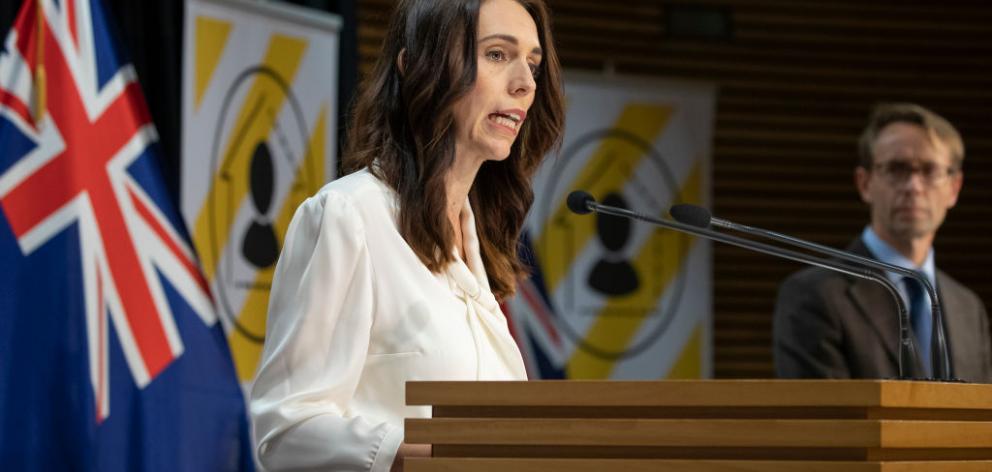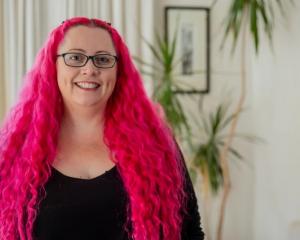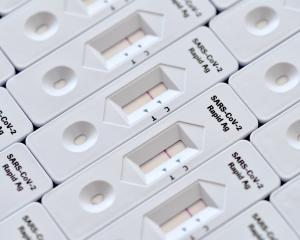*The PM's full speech is included at the bottom of this story
Prime Minister Jacinda Ardern has announced New Zealand's level 4 lockdown will end one week from today.
Ardern announced the decision to move out of level 4 at 11.59pm on Monday April 27 during a press conference from the Beehive which started at 4pm.
From then New Zealand will be in alert level 3 for two weeks and would move down alert levels after that two week period "only if it is safe".
- Alert level 3 - what does that mean for you?
- Bridges says Govt inaction to blame for longer lockdown
- No new cases in the South for second day running
- Taieri Gorge track to be mothballed, 51 jobs likely to go
- Lockdown should be extended two weeks: virus tracker
Level 4 had originally been scheduled to lift on Thursday this week.
But Cabinet wanted to "lock in some gains" and give more certainty, Ardern said.

"Ultimately we have taken a balanced approach," Ardern said.
Ardern said at every point along the way with making decisions the Government was based on both health and economic advice but NZ was in the fortunate position that those were both linked.
Lifting late on Monday - a public holiday because of Anzac Day - was also recommended by Bloomfield.
Any businesses needing to prepare to move into level 3 could be accessed, Ardern said, as could schools to prepare. April 28 will be a teachers' only day and April 29 will be the first day of term.
On businesses accessing their premises, it wasn't an invitation to open or trade, she said - just to prepare.
Testing will continue this week to ensure all demographics in the community were reached, Ardern said.
Will lockdown be extended next Monday?
On whether the lockdown could be extended further, Ardern said she wasn't expecting "any surprises" with the case numbers, and they were confident there wasn't community transmission.
Cabinet would decide on May 11 whether to move out of alert level 3.
They did consider lifting restrictions in different regions with fewer cases, but given how much movement there is around the country, she said they couldn't risk that for alert level 3.
It would be considered under alert level 2.
There was consensus in Cabinet about this decision, she said.
What does Level 3 mean?
Alert level 3 still has many restrictions and does not allow more social activity though allowing more commerce to re-open.
Ardern reminded the country of the principles of alert level 3:
- Stay home;
- Work and learn from home if you can;
- Make your business Covid-19 safe;
- Stay regional;
- Keep your bubble as small as possible;
- Wash your hands often with soap and cough into your elbow;
- If you're sick, stay home and get advice from a GP and do that quickly.
So this Anzac weekend, stay home and stay with your bubble and reflect on the sacrifices of our forebears, Ardern said.
"It was a very, very different battle from the one we're in now but the character of our country remains the same."
Ardern started the press conference by thinking of those who've lost a loved one, or almost lost a loved one, to Covid-19.
"We cannot forget that every number is someone's father, mother, relative or friend," she said.
She said the New Zealanders had stopped a "wave of devastation".
"We have done what very few countries have been able to do."
New Zealand had a transmission rate of 0.48% - one of the lowest in the world, she said.
Nearly every case is a result of overseas travel, an already confirmed case or a cluster.
Only 8 cases can't be traced to their source.
Random testing in communities had tested more than 1000 people and none had tested positive.
Bloomfield is sure there is no widespread community transmission, she said.
"We have broken the chain," Ardern said.

Health reforms needed
Ardern said there would be reforms in the health system.
"We've always said our health system needs to be rebuilt, I'm just not going to do it in a pandemic."
On creating the national system combining the 12 public health systems, Bloomfield said there is "both a need and value" of having the regional units linked at a national level.
"There is more to do though and we're very, very open about that," Ardern said.
What does elimination mean?
Elimination means "zero tolerance" so whenever a case props up, it's jumped on and eradicated, Ardern said.
She didn't want Kiwis to think they had failed if a case crops up, Ardern said.
When NZ goes to alert 3, the decision to move to alert level 2 would be based on the case numbers and where the transmission is happening, Ardern said.
Bloomfield said they'd want to know exactly where the cases came from at alert level 3.
New Zealanders needed to be even more cautious at alert level 3 because there wasn't the protection of the lockdown.
The NHI system now has contact details for more than 95 per cent.
The wage subsidy scheme wouldn't be extended as it was for 12 weeks, which the extra week would still fall into.
On the public opinion on the lockdown and how that weighed into Cabinet's decision, Ardern said data from Google showed New Zealanders' compliance had been really high and she took that as a sign that they supported the measures.
On restarting Parliament, Ardern said her preference was to leave it to the Business Committee and Cabinet would mirror that decision.
Director General of Health Ashley Bloomfield Bloomfield said they would continue to test symptomatic people and "hunt out" community cases which might exist.
Random testing would also continue and would start testing more workplaces.
Dr Ayesha Veralls' report will be released this afternoon after being considered by Cabinet.
Bloomfield said a number of her recommendations had been responded to and the Ministry would continue to respond to others.
Cabinet had been meeting since 10.30am to decide whether the lockdown will be lifted on Wednesday at 11.59pm.
Today there were nine new cases of Covid-19. There were also nine on Sunday.
Fourteen people are in hospital, including two in a critical condition, while 974 people have completely recovered from the deadly virus.
The death toll stands at 12.
Random testing to continue
Bloomfield said symptomatic people would continue to be tested and the Ministry would "hunt out" community cases which might exist.
Random testing would also continue and start testing more workplaces.
Up to 5000 contacts can be traced at the moment and the capacity would continue to be built so it could be scaled up rapidly. Nationalising the system would help achieve that, Bloomfield said.
A report by Dr Ayesha Veralls will be released this afternoon after being considered by Cabinet.
Bloomfield said a number of her recommendations had been responded to, and the Ministry would continue to respond to others.
About the contact tracing report, Bloomfield was complimentary about work being done and confident in the direction contact tracing was moving.
Recommendations included about how it could further be strengthened - including investing further in public health.
Bloomfield said they were "very confident" opening primary schools and ECE centres wasn't a risk.
Ardern said they hoped as many parents as possible would continue to keep their children at home.
Opening schools, however, allowed them to go back to work.
Getting school leaders to decide whether they open or which children should go back to school wasn't a "burden" they wanted to put on individual schools, Ardern said.
In response to questions, Ardern said NZ needed to "lock in" the gains it had made over the past few weeks.
Ardern said they only started considering the decision on the lockdown at the weekend.
Losing two business days was weighed up against the extra time it gave the lockdown.
"We get the greatest gains at the lowest cost. We know that's a big ask, we didn't take it lightly."
Ardern said the certainty it gave the country was worth the sacrifice.
"New Zealanders have proven themselves and they've done so in an incredible way."
On enforcement, Ardern said level 3 came with higher trust but there would still be police acting as enforcers which would act on large groups congregating.
"But there is more trust at alert level 3."
Ardern said the results of the lockdown "had all been achieved as a result of New Zealanders" and that's why she had trust in Kiwis to stay in their bubbles.
PM Jacinda Ardern's full speech

Over the past few weeks I have often used my time at this podium to acknowledge the people on the frontline.
Today I want to remember the people in New Zealand who have lost someone to COVID-19, or the many more who had the terror of almost losing someone.
Throughout this pandemic there have been individuals who I have tracked the progress of. I didn't know their names, but I knew their status. And I still get a phone call for every individual person we lose to COVID-19.
We may be amongst a small number of countries where that is still able to happen, where the numbers we have lost have been small, but we cannot forget that every number is someone's father, someone's mum, a relative and a friend and someone we have all been united in an effort to protect and to save.
And that is why we as a country took on the challenge of staring down COVID-19 – because we believed that decisive action, going hard and going early, gave us the very best chance of stamping out the virus. And it has.
We have done what very few countries have been able to do. We have stopped a wave of devastation.
Our transmission rate, the number of cases each person with the virus passes it onto, is now 0.48, less than half a person each. Overseas the average is 2.5 people. We have amongst the lowest number of confirmed cases per 100,000 people in the world.
We have a relatively low proportion of serious cases and, according to the Oxford University Coronavirus Government Response Tracker, one of the lowest mortality rates in the world.
Nearly every case identified since April 1 is as a result of overseas travel or contact with someone with the virus, often in existing clusters. The number of individual cases that don't have an obvious connection in that period stands now at only 8.
Our testing has scaled up and we have now tested over 85,000 New Zealanders, one of the highest testing rates per capita in the world.
In the last few days, we expanded testing to include random testing in Queenstown, the Waikato, Canterbury and Auckland. We have tested over a thousand people this way and so far have produced not a single positive result.
The Director General of Health is confident that there is currently no widespread undetected community transmission in New Zealand.
In short, the effort of our team of 5 million has broken the chain of transmission and taken a quantum leap forward in our goal to eliminate the virus.
Elimination doesn't mean zero cases, it means zero tolerance for cases. It means when a case emerges, and it will, we test, we contact trace, we isolate, and we do that every single time with the ambition that when we see COVID-19, we eliminate it. That is how we will keep our transmission rate under 1, and it is how we will keep succeeding.
And we have seen success.
You, all of you, have stopped the uncontrolled explosion of COVID-19 in New Zealand, and I couldn't feel prouder of the start we have made together.
But I also feel a huge responsibility to ensure that we do not lose any of the gains we have made either.
On that basis, New Zealand will move out of Alert Level 4 lockdown at 11.59pm on Monday April 27, one week from today. We will then hold in Alert Level 3 for two weeks, before reviewing how we are tracking again, and making further decisions at Cabinet on the 11th of May.
In making this decision, Cabinet discussed in depth all of the data we have shared with you daily. We looked at the gains we have made in our results, but also our systems.
We considered that the longer we are in lockdown, the less likely it is we will need to go back. We also considered moving alert levels on the 23rd of April, in just 48 hours' time.
The sacrifice made to date has been huge. And Cabinet wanted to make sure we lock in our gains, and give ourselves some additional certainty.
Waiting to move to alert levels next week costs us two more business days, but gives us much greater longer term health and economic returns down the track. It means we are less likely to go backwards.
Ultimately, we have taken a balanced approach, and one that the Director General of Health not only supported, but also recommended.
This time we now have will be used to prepare, on all fronts.
This week businesses will be allowed to get ready to open, such as employers re-entering premises to receive stock if necessary, but we ask that in doing so they stick to social distancing and their bubbles.
The same principle applies for preparing schools.
Schools and early learning centres can be accessed this week for cleaning, maintenance and any other preparations. The current plan is for schools to be able to re-open for a Teacher Only Day on 28 April as part of their preparation, and we expect those who need to attend, to be able to from 29 April. It may take a bit longer for some schools and early learning centres to be ready.
And from a health perspective, testing will continue including giving ongoing public confidence that we are reaching isolated, rural, maōri and pacific communities, contact tracing will be bolstered even further, and we will continue to use the best evidence, advice and modelling we have to make daily decisions to serve New Zealanders.
The most important thing to remember in the meantime though, is that all of this preparation takes us to an alert level in one week's time – a recovery room of sorts – that has many restrictions.
Yes Alert Level 3 allows more economic activity like construction, manufacturing and forestry, but it does not allow more social activity. And for good reason. If we want to make sure that we are a health success story, and ensure our economy can start to operate again without the virus taking off, we need to get the next phase right. The worst thing we can do for our country is to yo-yo between levels, with all of the uncertainty that this would bring.
We need to move with confidence. And that means following the rules.
So here's a reminder of the principles for Level 3 when we get there.
1. Stay home. If you are not at work, school, exercising or getting essentials, then you must be at home, the same as at Level 4.
2. Work and learn from home if you can. We still want the vast majority of people working from home, and children and young people learning from home. At-risk students and staff should also stay at home, and they will be supported to do so. Early learning centres and schools will physically be open for up to Year 10 for families that need them.
3. Make your business COVID-19 safe. COVID-19 has spread in workplaces, so the quid pro quo of being able to open is doing it in a way that doesn't spread the virus. Important industries like construction, manufacturing and forestry will be able to open, as will retail so long as it is contactless retail.
4. Stay regional. You can exercise at parks or beaches within your region, but the closer to home the better. Activities must be safe – keep 2 metres away from anybody not in your bubble. Make minimal trips.
5. Keep your bubble as small as possible. If you need to, you can expand your bubble a small amount to bring in close family, isolated people or caregivers.
6. Wash your hands often with soap. Then dry them. Cough into your elbow.
7. If you're sick stay at home and seek advice from your GP or Healthline about getting a test. And quickly. There is no stigma to COVID-19. None. We will only be successful if everyone is willing to play their part in finding it wherever it is.
These rules will be so important. We all want to continue to progress down the levels. The best hope of getting back to normal as soon as possible, is never getting ahead of where we are right now.
So, to recap. We are currently in lockdown, and are staying there for the next week.
From Tuesday morning the 28th of April we will move to Level 3 and stay there for two weeks. Those two weeks gives us another cycle of transmission to assess how we are doing. From there, we will move if we can and if we're ready.
But only when we're ready, and only when it's safe.
And so, this weekend, Anzac weekend, enjoy the company of your bubble, stay local, and reflect on the amazing sacrifice of our forebears.
Decades ago they came together in the most testing of circumstances half a world away and helped forge who we are today. It was a very different battle than the one we are in now, but the character of who we are as a country remains exactly the same.
So please, stay strong, stay home, be kind. And let's finish what we started.
Comments
We still haven't achieved one day of no new infections. It cannot be yet said we have stopped a wave of devastation as long as new infections are occurring which then keeps the virus alive in our country.














